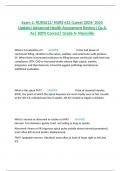Exam 2: NURS612/ NURS 612 (Latest 2024/ 2025
Update) Advanced Health Assessment Review| Qs &
As| 100% Correct| Grade A- Maryville
What is S4 indicative of? - ANSWER In the 2nd phase of
ventricular filling, vibration in the valves, papillae, and ventricular walls produce
S4. When there is increased resistance to filling because ventricular walls have lost
compliance. HTN, CAD or increased stroke volume high output, anemia,
pregnancy, and thyrotoxicosis. A loud S4 suggest pathology and deserves
additional evaluation.
What is the apical PMI? - ANSWER Point of maximal impulse
(PMI), the point at which the apical impulses are most readily seen or felt. Usually
at the 5th ICS, midclavicular line in adults. 4th ICS medial to nipple in children.
What is normal or abnormal in relation to PMI? - ANSWER
Normal- 1cm diameter, gentle, brief, not lasting as long as systole.
Abnormal- Heave or lift (vigorous apical pulse outside above normal parameters),
most often left sternal border, displacement.
Thrill- (palpable murmur, vibration) most often at base of heart right or left 2nd
ICS.
, When assessing family history what questions do you ask for CV history? -
ANSWER Long QT syndrome. Marfan syndrome-genetic, connective
tissue disease MVR/MVP, AR, AD. DM, heart disease, HLD, HTN, obesity,
congenital heart disease, morbidity, mortality r/t heart, age at time of illness or
death, especially young and middle age relatives.
What questions do you ask for patient history in MI? - ANSWER
Heart surgery/hospitalization for cardiac evaluation, congenital heart disease,
rhythm, acute rheumatic fever, Kawasaki disease.
What creates each heart sound? - ANSWER S1-first heart sound
(lub), ventricular contraction, closure of the mitral and tricuspid valve (AV valve),
beginning of systole, heard best at apex, lower pitch.
S2-Second heart sound (dub), aortic and pulmonic valve closure (SL valves), end of
systole, best heard at base, higher pitch.
S3-Early passive diastole phase that causes distention in the ventricular walls and
vibration, ventricular filling phase, best heard in the left lateral recumbent
position, Ken-TUCK-y, right after S2.
S4-2nd phase of active ventricular filling, vibration in the valves, papillae, and
walls produce sound, TEN-nes-see, right before S1.




